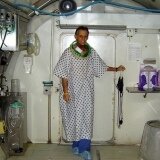Blast Injury and Hyperbaric Oxygenation
Featured article. Page 4.
Acute Brain and Cardio-Respiratory Dysfunction After Blast/Blunt Injuries: The Life-Preserving Effects of Hyperbaric Oxygenation
Gennady G. Rogatsky and Avraham Mayevsky
The Mina & Everard Goodman Faculty of Life Sciences and the Leslie and Susan Gonda Multidisciplinary Brain Research Center, Bar-Ilan University, Ramat-Gan 52900, Israel
B. Human Studies
1. Acute Cardio-respiratory Changes
In the available literature, we could not find data regarding the character of changes in myocardial contractility in blast injury victims. Also, there is only quite scant data regarding this question for victims of blunt chest injury. However, as shown by Rady et al.168 and Rogatsky and Mayevsky,182 early depression of cardiac function is associated with poor outcome in victims with thoracic blunt trauma.
As has been also revealed in the studies of pulmonary gas exchange in blast injury models,68,107,108,113 such characteristic arterial hypoxemia development was observed in clinical investigations of severe blast injury victims.12,164,198,241 Thus, Pizov et al.164 observed that the majority of victims (10 out of 15), admitted to ICU, had the PaO2 level less than 65 mm.
This necessitated the various subsequent intervention measures (after draining the pneumo-thorax), restoring the level of pulmonary gas exchange: positive pressure, ventilation, independent lung ventilation, nitric oxide and extra-corporal membrane oxygenation, etc. Zhen et al.241 noted a decrease in PaO2<75% in severe blast injury victims, requiring the performance of tracheostomy.
2. Brain Disorders
As has been noted above, secondary and tertiary blast injuries usually produce more severe disorders of the brain, which are the most common cause of death in terrorist bombings.65,78,132,213 It is known that one of the most serious disturbances in head injury is the reduction in cerebral blood flow. Thus, for example, Bouma et al. showed that ischemia is strongly associated with early mortality of head injury victims, whereas normal or high CBF values were not predictive of favorable short-term outcome.29-31
Studies of CBF have documented a decreased flow in over 50% of patients with TBI, in the acute phase.225 It was also noted that cerebral ischemia insult occurred in at least 30% of severely head-injured patients at a very early stage after trauma, and was associated with early death.191 The results of that research indicated that the proportion of patients with CBF less than or equal to 20 ml/100 g was 50% among the non-survivors, and only 5% among the survivors. The difference in CBF proportions was significant at p<0.001 (Chi-square test).
In determining complex cause-effect relations of various pathophysiological mechanisms of severe blast injury, it seems important to note the researches of subsequent years that recurrently confirmed the fact of pathophysiological conditioning of ARDS development under acute, isolated head injury.20,184,190 In addition, there is a considerable amount of publications demonstrating the early development of neurogenic pulmonary edema, even under isolated head trauma.17,41,184
It has been noted that, in these cases, neurogenic pulmonary edema can result from cardiac dysfunction.15 Studies of the past decades have established the fact of the development of acute cardio-pulmonary dysfunction, which was recorded already at the initial stage of severe head trauma.84,104,210,226 In this case, cardiopulmonary dysfunction induces pronounced pathophysiological perturbations, usually accompanying severe head injury, such as apnea, hypoxia, hypercarbia, and catecholamine surge.11 Excessively high elevation of catecholamine levels causes myocardial damage and cardiac failure.11,166
The use of a new technique – the direct measurement of partial brain tissue oxygen pressure (PbtO2) – not only allowed to solve the problems of actual continuous monitoring of brain oxygen supply in order to optimize the management of acute head injury victims,200,223,224,243 but also made it possible to attempt to elucidate several important pathophysiological questions in the clinical management and experimental models of head injury.60,128,136,238,239
Thus, the researches from Baylor College of Medicine (Houston, Texas) showed that, by hyperoxia, the PbtO2 can be increased even in the ischemic areas of the brain of TBI victims.221, 99 This task was accomplished by increasing the P/F ratios while conducting artificial ventilation, thereby preventing PbtO2 decline and the corresponding poor outcome for patients with acute head injury.186










